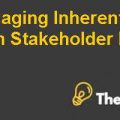Hydrogen Engine project Case Study Analysis
Introduction
Cummins Inc. is an American-based multinational company formed in 1919 by Clessie Lyle Cummins and J Irwin Miller that providing its services by manufacturing, developing and distributing engines, power generation equipment and filters. The company has extended and diversified its operations in several industries like construction, agriculture, bus, mining, commercial power, oil and gas etc. The company has got the distinction in the Ethisphere Worlds Most Ethical Companies list for 14 years consecutively. Cummins has a wide distribution network with around 58000 employees.
It has more than 600 distributors owned by company and working independently. The company is serving 190 countries and has over 7200 dealers that has significantly added value for the company. Cummins has gain a substantial proficiency over the years and is multinational company that has been functioning since 1919. With the continued demand of greener and cleaner environment Cummins has proposed to launch a 15L and 6.7L hydrogen engine, expected to begin production in the year 2027. The company is expecting its hydrogen engine to ne competent on a cost-basis with the diesel engine by the year end 2030.
Research Objectives
The objective of the research on the Cummins Hydrogen Engine project is to gain the insights for the proposed project that whether the project has worthwhileness to invest in. The research will try to answer the concerned questions regarding the project feasibility and potential profitability through several market and financial aspects. Different market and financial analyses will be conducted to measure the value proposition of the project.
Research Questions
The research is based the questions that would provide the investors the details required for consideration on investing in the projects.
- What are the existing capabilities and business models and how would the project be initiated? What is the target market and how would the project benefit the industry in the next 25 years?
- What is the competitive dynamic in the Cummins and what are the factors that would derive the success of the project? What is the competitive positioning in the industry?
- How would the project be able to create value proposition?
- What is the financial projection and what is the indication of viability?
Market Presence
The current market scenario of hydrogen engines and power presents various factors that indicate the market conditions and acceptance of hydrogen power as a new technology. There are different factors and elements are discussed that help to understand the market growth, product capabilities, initiatives put by Cummins and other players, and targeted segment to improve the market capability for hydrogen engines.
Pestle analysis
Political factors
Hydrogen technologies have the potential to be a major driver of decarbonization across hard-to-abate industries. Specifically, hydrogen fuel cells and electrolyzers can offer an inexpensive and low-carbon solution for power generation and transportation, as well as other industrial processes.
There are several companies working on hydrogen-fueled engines, including Cummins and German engine development specialist FEV. They are all committed to bringing this technology to market.
As part of their Destination Zero strategy, both companies have developed a new fuel-agnostic platform and announced significant supply deals to support decarbonization in key markets such as commercial trucking, agriculture and rail.
As the leader in engines and drivetrains, Cummins is uniquely positioned to serve customers’ needs with the full spectrum of traditional and hydrogen solutions. This is a huge advantage, as it makes it easier for customers to make informed decisions. Moreover, Cummins has the expertise to help develop and scale hydrogen-fueled engines that meet the demands of hard-to-abate industrial applications.
Economic factors
Hydrogen is a fuel that can power engines and vehicles, but it also provides an important source of energy for other devices. For example, it is used in hydrogen fuel cells to generate electricity or green gas that can be stored onboard vehicles.
Several companies are developing engines using hydrogen to reduce emissions. Among them is Cummins (NYSE: CMI), which has begun testing a medium-duty 6.7-liter and a heavy-duty 15-liter hydrogen-fueled internal combustion engine.
These engines will be based on next-generation platforms to meet the needs of multiple applications, and provide zero carbon emissions. In addition, they will offer improved power density and thermal efficiency to enhance overall system performance................
Hydrogen Engine project Case Study Analysis
This is just a sample partial case solution. Please place the order on the website to order your own originally done case solution.













